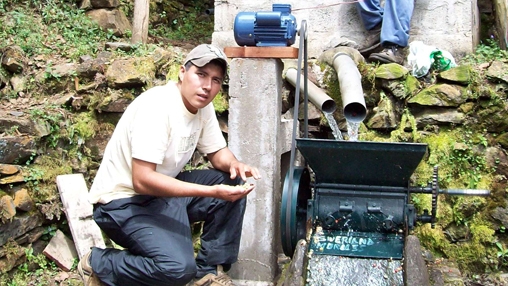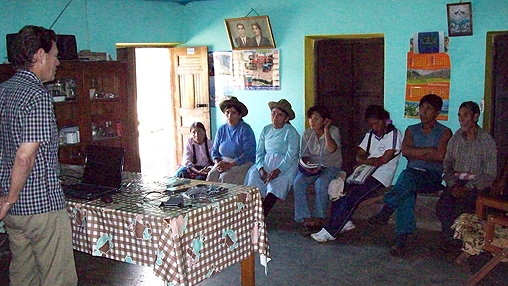News
- This rural energy project included a pilot program to promote productive uses of electricity, supported over 4,970 families and micro-enterprises to adopt electricity to process cereals, coffee, cocoa, baked goods, meat products, milk, wood and metal products and handicrafts, and to pump water for expanded agricultural production and processing.
- The project implemented an approach based on business development services (BDS) techniques. The non-governmental organization (NGO) implementing the productive uses activities used BDS methods to assist small and home-based enterprises in gathering information, finding credit and addressing technology constraints through marketing and assistance campaigns.
This rural energy project, which included a pilot program to promote productive uses of electricity, supported over 4,970 families and micro-enterprises to adopt electricity to process cereals, coffee, cocoa, baked goods, meat products, milk, wood and metal products and handicrafts, and to pump water for expanded agricultural production and processing.
Challenge
The rural communities in Peru faced multiple barriers to increasing the use of electricity for production. The constraints on promoting demand for electricity from productive units included (i) limited technical and management skills of rural producers, (ii) inadequate access to capital and financing, and (iii) poor quality perception of grid supplied electricity, which reduced interest in electrical equipment.
From the perspective of the supplier, the constraints to meeting the additional demand included (i) a lack of marketing or tracking of productive-use customers by distribution companies, (ii) limited access to information and insights on rural markets, (iii) rural electrical system designs and network layouts optimized for least-cost household connections, rather than maximum development benefits, and (iv) inconsistent service quality in many of the poorer communities, with interruptions and voltage drops.
Solution
The project implemented an approach based on business development services (BDS) techniques. The non-governmental organization (NGO) implementing the productive uses activities used BDS methods to assist small and home-based enterprises in gathering information, finding credit and addressing technology constraints through marketing and assistance campaigns. The BDS approach has been applied in rural programs targeting income generating activities in other sectors by working, often in collaboration with other institutions, to assist enterprises improve and start small businesses by addressing technical skills, markets, finance, technology and other constraints. For its application to promote productive uses of electricity, the NGOs followed a strategy that included the following elements:
- market assessment;
- preparation of business plans;
- marketing to the community and potential entrepreneurs;
- coordination with complementary institutions; and
- links with the electricity distribution company.
Results
The projects were carried out in areas with different geographical conditions and economic activities. The pilot project areas ranged from the semi-arid coastal communities in Lima provinces, to the Andean highlands in Junín and Cusco, Amazon rain forests in Junín and the steep terrain of the high altitude cloud forests in the Cusco region. The main economic activities in the targeted communities are home based or located in or near the fields of the producer. They vary within the range of small scale agriculture, livestock and dairy production, artisanal mining, textiles, off-farm industries and services like transport or product distribution. While agricultural production is usually at the individual level, agricultural processing is often done at a cooperative or association level.
Women entrepreneurs play a significant role in areas of production such as baked goods, milk production, ceramics and textiles, and are represented in all types of activities. The implementation approach, while not deliberately designed with gender in mind, seems to have been effective in reaching women producers. Overall, one third of the participants were women, and in the Cusco region this number increased to almost two thirds of the participants.
Thus far, the pilot project activities have helped over 4,970 families and micro-enterprises to adopt electricity and use equipment to process cereals, coffee, cocoa, baked goods, meat products, milk, wood and metal products and handicrafts, and to pump water for expanded agricultural production and processing. It is expected that by project closing 9,000 families/micro-enterprises are supported in the adoption of productive uses of electricity.

Coffee processing in the Sierra region, Peru
Edgar Gonzalez, DFC
Bank Group Contribution
The Energy Sector Management Assistance Program (ESMAP) financed technical assistance (US$80,000) to support the productive uses of electricity contributed significantly by providing the technical support for the implementation of the productive uses component in the Bank and GEF-supported Rural Electrification Project (US$144 million total, including US$50 million Bank and US$10 million GEF).
Partners
The Bank and the Global Environmental Facility (GEF) are supporting the Ministry of Energy and Mines’ (MEM) Directorate of Competitive Funds of the General Directorate of Rural Electrification (DGER) in the implementation and execution of the project.
Moving Forward
The theme of this project has been integrated into Government objectives—MEM’s National Plan for Rural Electrification includes capacity building for productive uses as a key objective. The second rural electrification project will work to make promotion of productive uses an integral part of rural electrification activities of the DGER rather than a separate pilot activity.

Working with the local community in the Cusco region, Peru
Edgar Gonzalez, DFC
Beneficiaries
The electrification of six groundwater pumping stations for prickly pear and cochineal production in Piedra Grande for 46 farmers—organized by the NGO Desco—was the model project to promote the productive use of electricity. Desco produced a study that allowed producers to make the decision on the investment in equipment and organized its execution.
Previously, to operate the diesel or gasoline pumps, the farmers descended into the well to turn the pumps on and off up to six times a day, with the risks of working at depth and in a confined space full of carbon monoxide. Tragic losses and, to a lesser degree, the high costs of fuel led to a strong commitment by the community to take advantage of electric pumps with above ground switches.
